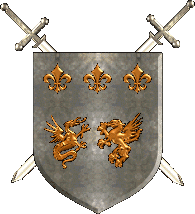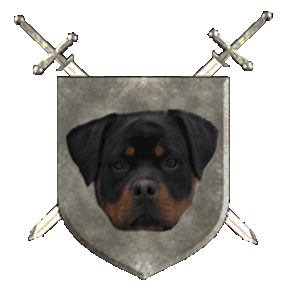|

When the ancient Romans invaded Europe they had to eat somehow. To solve that
problem they brought herds of cattle with them. Big mastiff type dogs were used to herd, drive, and guard these animals. These
mastiffs were supposedly the ancestors of the Rottweiler.
The Romans captured a small town called Rottweil. The Romans big mastiff dogs
bred with some of the local farm dogs in Rottweil and henceforth came the Rottweiler.
The people in Rottweil (and most every where else in the world back then) would
not keep a dog if it wasn’t useful for anything. So, they put the Rottweilers to work. The butchers would use the dogs
to herd their cattle and other animals.
The butchers also found another use for the big, strong, and brave Rottweilers.
Sometimes, on the way home from market the butchers would get robbed. They found that if they tied their money around their
Rottweiler’s neck in a leather pouch, then nobody would want to get close to the dog and steal the money.
Later on in the Middle Ages Rotts were used to pull carts. This is one of the
two reasons many say why Rotties tails are docked. Tails get in the way of moving parts when pulling carts, so they simply
cut them off when the puppies were a few days old. The other suggested reason why tails are docked is because Rotties were
sometimes used as boar hunting dogs. The absence of a tail was one less thing to get damaged during a fight.
Centuries later, railroads and trains were invented. They grew very popular. Often
enough cattle would be transported by railroad instead of by Rottweilers herding and driving them. And bad for the Rottweiler
breed, in the middle of the 19th century driving cattle over roads became forbidden by law.
A little before World War I, only 1 Rottweiler bitch (female) existed in Rottweil.
Fortunately, in 1901, efforts were made to form a Rottweiler/Leonberger club. This club did not last long but all Rottweiler
lovers can be thankful to the club for producing the first Rottweiler breed standard. Rottweilers have not changed much at
all in personality, character, or physical appearance since this first breed standard.
In 1910 Rottweilers were recognized as police dogs along with German Shepherds,
Doberman Pinschers, and Airedale Terriers.
In 1931 the first Rottweilers were imported to the United States. The dogs suffered
again during World War II but after the war, numbers began to increase.
In 1997 Rottweilers ranked 2nd in American Kennel Club (AKC) registrations. Then
in 1998 it fell to 4th. Last year, 1999, it fell all the way to 8th.
By looking at the Rottweiler's history, you can see why they are what they are.
For instance, if you own a Rottweiler, you've probably felt at one time or two the intense strength of a full grown Rottie.
But they were intentionally bred to be that way so they could be good at pulling carts.
Rottweilers have not changed a whole lot since ancient times in Rottweil. They
still love to work and need to be kept busy. Even today people sometimes keep small valuables in a pouch tied around their
Rottie’s neck.
ROTTWEILER BREED STANDARD ACCORDING TO AKC
(LISTED BELOW)
General Appearance
The ideal Rottweiler is a medium large, robust and powerful dog, black
with clearly defined rust markings. His compact and substantial build denotes great strength, agility and endurance. Dogs
are characteristically more massive throughout with larger frame and heavier bone than bitches. Bitches are distinctly feminine,
but without weakness of substance or structure.
Size, Proportion, Substance
Dogs--24 inches to 27 inches. Bitches--22 inches to 25 inches, with preferred size being mid-range of each sex. Correct
proportion is of primary importance, as long as size is within the standard's range. The length of body, from prosternum to
the rearmost projection of the rump, is slightly longer than the height of the dog at the withers, the most desirable proportion
of the height to length being 9 to 10. The Rottweiler is neither coarse nor shelly. Depth of chest is approximately fifty
percent (50%) of the height of the dog. His bone and muscle mass must be sufficient to balance his frame, giving a compact
and very powerful appearance. Serious Faults--Lack of proportion, undersized, oversized, reversal of sex characteristics
(bitchy dogs, doggy bitches).
Head
Of medium length, broad between the ears; forehead line seen in profile is moderately arched; zygomatic
arch and stop well developed with strong broad upper and lower jaws. The desired ratio of backskull to muzzle is 3 to 2. Forehead
is preferred dry, however some wrinkling may occur when dog is alert. Expression is noble, alert, and self-assured. Eyes of medium size, almond shaped with well fitting lids, moderately deep-set, neither protruding nor receding. The desired
color is a uniform dark brown. Serious Faults--Yellow (bird of prey) eyes, eyes of different color or size, hairless
eye rim. Disqualification--Entropion. Ectropion. Ears of medium size,
pendant, triangular in shape; when carried alertly the ears are level with the top of the skull and appear to broaden it.
Ears are to be set well apart, hanging forward with the inner edge lying tightly against the head and terminating at approximately
mid-cheek. Serious Faults--Improper carriage (creased, folded or held away from cheek/head). Muzzle--Bridge is straight, broad at base with slight tapering towards tip. The end of the muzzle is broad with well developed
chin. Nose is broad rather than round and always black. Lips-Always black; corners closed; inner mouth pigment is preferred
dark. Serious Faults--Total lack of mouth pigment (pink mouth). Bite and Dentition--Teeth
42 in number (20 upper, 22 lower), strong, correctly placed, meeting in a scissors bite--lower incisors touching inside of
upper incisors. Serious Faults--Level bite; any missing tooth.Disqualifications--Overshot,
undershot (when incisors do not touch or mesh); wry mouth; two or more missing teeth.
Neck, Topline, Body
Neck--Powerful, well muscled, moderately long, slightly arched and without
loose skin. Topline--The back is firm and level, extending in a straight line from behind
the withers to the croup. The back remains horizontal to the ground while the dog is moving or standing. Body--The chest is roomy, broad and deep, reaching to elbow, with well pronounced forechest and well sprung, oval ribs.
Back is straight and strong. Loin is short, deep and well muscled. Croup is broad, of medium length and only slightly sloping.
Underline of a mature Rottweiler has a slight tuck-up. Males must have two normal testicles properly descended into the scrotum. Disqualification--Unilateral cryptorchid or cryptorchid males. Tail--Tail docked short, close to body,
leaving one or two tail vertebrae. The set of the tail is more important than length. Properly set, it gives an impression
of elongation of topline; carried slightly above horizontal when the dog is excited or moving.
Forequarters
Shoulder blade is long and
well laid back. Upper arm equal in length to shoulder blade, set so elbows are well under body. Distance from withers to elbow
and elbow to ground is equal. Legs are strongly developed with straight, heavy bone, not set close together. Pasterns are
strong, springy and almost perpendicular to the ground. Feet are round, compact with well arched toes, turning neither in
nor out. Pads are thick and hard. Nails short, strong and black. Dewclaws may be removed.
Hindquarters
Angulation of hindquarters
balances that of forequarters. Upper thigh is fairly long, very broad and well muscled. Stifle joint is well turned. Lower
thigh is long, broad and powerful, with extensive muscling leading into a strong hock joint. Rear pasterns are nearly perpendicular
to the ground. Viewed from the rear, hind legs are straight, strong and wide enough apart to fit with a properly built body.
Feet are somewhat longer than the front feet, turning neither in nor out, equally compact with well arched toes. Pads are
thick and hard. Nails short, strong, and black. Dewclaws must be removed.
Coat
Outer coat is straight, coarse, dense, of medium length and lying flat.
Undercoat should be present on neck and thighs, but the amount is influenced by climatic conditions. Undercoat should not
show through outer coat. The coat is shortest on head, ears and legs, longest on breeching. The Rottweiler is to be exhibited
in the natural condition with no trimming. Fault--Wavy coat. Serious Faults--Open, excessively short,
or curly coat; total lack of undercoat; any trimming that alters the length of the natural coat. Disqualification--Long coat.
Color
Always black with rust to mahogany markings. The demarcation between black
and rust is to be clearly defined. The markings should be located as follows: a spot over each eye; on cheeks; as a strip
around each side of muzzle, but not on the bridge of the nose; on throat; triangular mark on both sides of prosternum;on forelegs
from carpus downward to the toes; on inside of rear legs showing down the front of the stifle and broadening out to front
of rear legs from hock to toes, but not completely eliminating black from rear of pasterns; un-der tail; black penciling on
toes. The undercoat is gray, tan, or black. Quantity and location of rust markings is important and should not exceed ten
percent of body color. Serious Faults--Straw-colored, excessive, insufficient or sooty markings; rust marking
other than described above; white marking any place on dog (a few rust or white hairs do not constitute a marking). Disqualifications--Any base color other than black; absence of all markings.
Gait
The Rottweiler
is a trotter. His movement should be balanced, harmonious, sure, powerful and unhindered, with strong forereach and a powerful
rear drive. The motion is effortless, efficient, and ground-covering. Front and rear legs are thrown neither in nor out, as
the imprint of hind feet should touch that of forefeet. In a trot the forequarters and hindquarters are mutually coordinated
while the back remains level, firm and relatively motionless. As speed increases the legs will converge under body towards
a center line.
Temperament
The Rottweiler is basically a calm, confident and courageous dog with a self-assured aloofness that does not lend
itself to immediate and indiscriminate friendships. A Rottweiler is self-confident and responds quietly and with a wait-and-see
attitude to influences in his environment. He has an inherent desire to protect home and family, and is an intelligent dog
of extreme hardness and adaptability with a strong willingness to work, making him especially suited as a companion, guardian
and general all-purpose dog. The behavior of the Rottweiler in the show ring should be controlled, willing and adaptable, trained
to submit to examination of mouth, testicles, etc. An aloof or reserved dog should not be penalized, as this reflects the
accepted character of the breed. An aggressive or belligerent attitude towards other dogs should not be faulted. A judge shall
excuse from the ring any shy Rottweiler. A dog shall be judged fundamentally shy if, refusing to stand for examination, it
shrinks away from the judge. A dog that in the opinion of the judge menaces or threatens him/her, or exhibits any sign that
it may not be safely approached or examined by the judge in the normal manner, shall be excused from the ring. A dog that
in the opinion of the judge attacks any person in the ring shall be disqualified.
Summary
Faults - The foregoing is a description of the ideal Rottweiler. Any structural
fault that detracts from the above described working dog must be penalized to the extent of the deviation. Disqualifications
Entropion,
ectropion. Overshot, undershot (when incisors do not touch or mesh); wry mouth; two or more missing teeth. Unilateral cryptorchid
or cryptorchid males. Long coat. Any base color other than black; absence of all markings. A dog that in the opinion of the
judge attacks any person in the ring.
|

